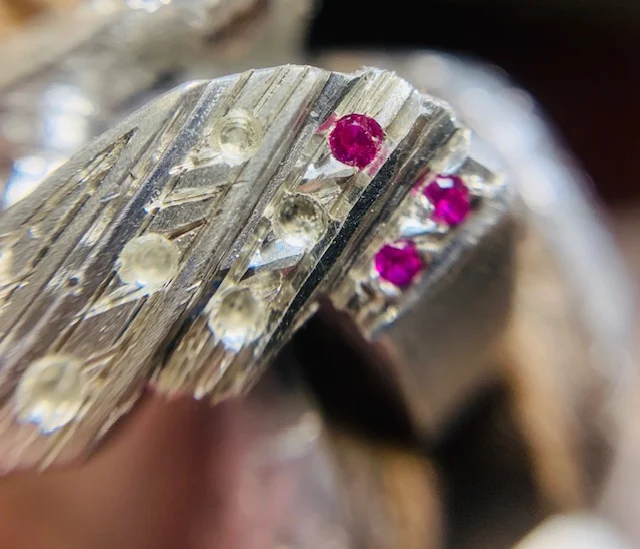In this extraordinary essay, I want you to follow the numerous steps in Pave' setting. Remembering, that nothing was created with the help of CAD. The only guide I had were the few holes in the metal ring.
WHAT ARE THE TOOLS TO CREAT THIS PAVE' SETTING?
The tools are few, but the results are mindboggling as you will soon see.
1) Onglette graver #1
2) Rounded (Bead-Raiser) underneath front of the Onglette graver #2.
3) Flat graver #40
4) Bead Burnisher (not shown)
=============================================
The Difficulty Level for this (detailed) exercise is 8.0 out of 10.
Shall we now start?
--------------------------------------------------------------------------------
Once that we have the holes drilled to the specifications for the diameter of the stones, just lay the stones aside until absolutely needed.
The very first thing 'we' do is to draw a line (cut) in the metal with your Onglette #1 graver, Where and why?
The Onglette graver must enter the edge of the hole, the front of the graver must dig into the hole DEEP, then cut this line again once more.
This first line of cutting should be as a sample to what we are aiming for here. The deeper 'we' cut the better the overall results. There should be 'no shallow cutting, the deeper the merrier'.
In this photo, the 'rough cutting line' is still too shallow. Get your Onglette #1 graver to cut DEEP!!!
At the end of the ">" line, the graver should create a DEEP 'V' shape, as shown. What remains are two triangles, these Triangles will eventually be your new Beads, agree?
1) Always have your burs in close contact to your work areas. That Red thing is your 'thumb guard', why is it used? The bottom of the graver rests against the finger-pad and as it's very sharp, it could cut into your skin. WOOPS!
2) The wax pick-up seen laying against the bur sleeves is what you should use to pick up your stones. Please don't use your tweezers, as you will surely have a few of them fly away and never to see them again.
3) Always have your 10x power Loupe always accessible to examine how the stones are sitting in the metal.
As seen here are your selected Ruby synthetic stones and the burs that you chose.
Many times I will use my "156C" Carbide bur, I will use them to create a seat against each new bead. This way there will be no crooked stones being set.
Inside and in the bottom of each hole there will be a deeper recess just for the Culet of the stone. If you don't drill for the Culets, the stone won't sit deep as you need them.
In this photo you can see five of the stones in their respective spots. At this juncture, use your Bead-Raiser (Onglette #2) and move the two beads over the Girdle of those 5 stones.
When a group of stones have being set, use your Bead-Burnisher and secure each bead. This will create a 'rounded finish' on the tip of each Bead, plus rendering each Bead tight against and secure during the many years of wear.
Bright-Cutting is a delicate form of cutting. Every Flat graver that is used MUST HAVE A HIGHLY POLISHED SURFACE. This polished graver will create a mirror-like surface that's being used.
In using an Onglette graver #1 (or #0 width) it is incumbent to keep the the graver sharp all the time. This is similar to 'marking the surface', but this time the operator of the graver will decide where the cutting will commence and finish.
I'm working on a few cutting designs during this writing. BTW, the graver MUST CUT ALONG EACH HOLE. The graver-tip should cut and enter the wall of each hole.
There is no other way to create Beads or Bright-Cutting if it isn't prepared by using your Onglette #1 graver.
There are NO SHORT-CUTS IN DIAMOND SETTING, either you nor I have that ability to do any gemstone cutting fast and still make it look good!!
In this particular ring (project) Graver cutting takes first place in enhancing the metal. Cloth-Wheel Polishing does not work well in this respect.
The Flat graver #40 is often used in making the metal equal to a strong reflecting mirror.
BTW, only a 'Flat #4' graver that is highly polished on #400 or #800 grit "Polishing Paper" is the only paper to use for these projects.
I chose to use this ring for its many intricate metal carving areas. I didn't spend too much time in the ring cleaning, as this was not needed on this topic.
In my previous essays, you saw how Bright-Cutting was achieved. I will do this same tutorial-essay topic again, as a reminder of this very important 'finishing' technique.
.jpg)

.jpg)












No comments:
Post a Comment